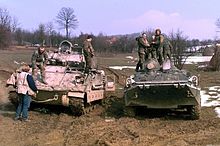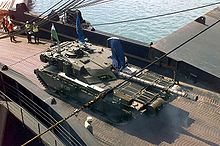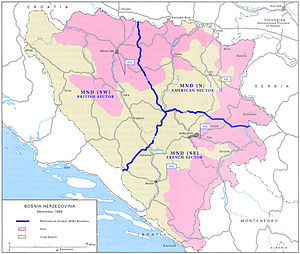- Implementation Force (IFOR)
-
The acronym IFOR may also refer to the International Fellowship of Reconciliation.Maritime Monitor – Sky Monitor – Maritime Guard – Deny Flight – Sharp Guard – Deliberate Force – IFOR – SFOR
The Implementation Force (IFOR) was a NATO-led multinational peacekeeping force in Bosnia and Herzegovina under a one-year mandate from 20 December 1995 to 20 December 1996 under the codename Operation Joint Endeavour. Its task was to implement the military Annexes of The General Framework Agreement for Peace (GFAP) in Bosnia and Herzegovina. It relieved the UN peacekeeping force UNPROFOR, which had originally arrived in 1992, and the transfer of authority was discussed in Security Council Resolution 1031. Almost 60,000 NATO troops in addition to forces from non-NATO nations were deployed to Bosnia. Operation Decisive Endeavor (SACEUR OPLAN 40105), beginning 6 December 1995, was a subcomponent of Joint Endeavor.[1] NATO was accountable for carrying out the Dayton Peace Accords. The Dayton Peace Accords were started on November 22, 1995 by the presidents of Bosnia, Croatia, and Serbia, on behalf of Serbia and the Bosnian Serb Republic. The actual signing happened in Paris on December 14, 1995. The peace accords contained a General Framework Agreement and eleven supporting annexes with maps. The accords had three major goals: ending of hostilities, authorization of military and civilian program going into effect, and the establishment of a central Bosnian government while excluding individuals that serve sentences or under indictment by the International War Crimes Tribunals from taking part in the running of the government.
The Dayton Agreement resulted from a long series of events. Notably, the failures of EU-led peace plans, the August 1995 Croat Operation Storm and its aftermath, the Bosnian Serb atrocities, in particular the Srebrenica massacre, and the seizure of UNPROFOR peace-keepers as human shields against NATO's Operation Deliberate Force.
Challenger 1 tank of the British Army with IFOR markings on a loading ship
Admiral Leighton W. Smith, Jr. (Commander in Chief Allied Forces Southern Europe (CINCSOUTH)) acted as the Joint Force Commander for the operation (also known as Commander IFOR (COMIFOR)). He commanded the operation from HQs in Zagreb and later from March 1996 from the Residency in Sarajevo.[citation needed] Lt Gen Michael Walker, Commander Allied Command Europe Rapid Reaction Corps (ARRC) acted as the Land Component Commander for the Operation, commanding from HQ ARRC (Forward) based initially in Kiseljak and from late January 1996 from HQ ARRC (Main) Ilidža. This was NATO's first ever out-of-area land deployment. The Land Component's part of the operation was known as Operation Firm Endeavour.
At its height, IFOR involved troops from 32 countries and numbered some 54,000 troops in-country (BiH) and around 80,000 involved troops in total (with support and reserve troops stationed in Croatia, Hungary, Germany, and Italy and also on ships in the Adriatic Sea). In the initial phases of the operation, much of the initial composition of IFOR consisted of units which had been part of UNPROFOR but remained in place and simply removed their United Nations insignia.
Contents
Components
NATO nations that contributed forces included Belgium, Canada, Denmark, France, Germany, Italy, Luxembourg, The Netherlands, Norway, Portugal, Spain, Turkey, The United States of America, and the United Kingdom. Non-NATO nations that contributed forces included; Austria, Bangladesh, the Czech Republic, Egypt, Estonia, Finland, Hungary, Latvia, Lithuania, Malaysia, New Zealand, Pakistan, Poland, Slovak Republic, Sweden, the Russian Federation and Ukraine[2]
The tasks of the Land Component were carried out by three Multi National Divisions:
- Multi-National Division (South-East) (Bosnia), Mostar - French led. Also known as the 'Division salamandre.'[3] The divisional headquarters was provided in rotation by divisions including the 7th Armoured Division and the 6th Light Armored Division.
- Multi National Division South West, Banja Luka - British led. The British codename for their armed forces' involvement in IFOR was Operation Resolute. MND-SW included a British brigade which also included a Malaysian armoured battle group, and a Canadian brigade, 2nd Canadian Multinational Brigade, which included a Czech battalion. Division headquarters was provided by 3 (UK) Division and 1st Armoured Division.
- MND(N), Tuzla - American led. Task Force Eagle. The US Army 1st Armored Division under the command of Major General William L. Nash, constituted the bulk of the ground forces for Task Force Eagle. They began to deploy on 18 December 1995. MND-N was composed of two U.S. Brigades, a Russian brigade, a Turkish brigade, and the Nordic-Polish Brigade.
- A Russian brigade, initially under the command of Colonel Aleksandr Ivanovich Lentsov, was part of the Task Force Eagle effort.[4]
 A Russian BTR 80 Personnel Carrier (right) from the Russian Military Police, 1st Battalion Airborne Brigade, 76th Airborne Division parks next to a Bradley Fighting Vehicle from B troop, 3rd Squadron, 4th Cavalry Regiment, 2nd Brigade, 1st Armored Division for a moment during a joint patrol around the Bosnian town of Zvornik on the afternoon of 29 February 96 in support of Operation Joint Endeavor.
A Russian BTR 80 Personnel Carrier (right) from the Russian Military Police, 1st Battalion Airborne Brigade, 76th Airborne Division parks next to a Bradley Fighting Vehicle from B troop, 3rd Squadron, 4th Cavalry Regiment, 2nd Brigade, 1st Armored Division for a moment during a joint patrol around the Bosnian town of Zvornik on the afternoon of 29 February 96 in support of Operation Joint Endeavor.
-
- The 1AD 1st Brigade was commanded by Colonel Gregory Fontenot and covered the northwest. The 1AD 2d Brigade, led by Col John Batiste, constituted the southern flank of the US sector, based in Camp Lisa, about 20 km east of Kladanj. Task Force 2-68 Armor, based in Baumholder, Germany (later re-flagged to 1-35 AR), was based in Camp Linda, outside of Olovo. This was the Southern boundary of the US Sector. The 1AD returned in late 1996 to Germany.
- One of MND-N's components was the Nordic-Polish Brigade (NORDPOLBDE) (Polish: Brygada Nordycko-Polska) which was a multinational brigade of Denmark, Estonia, Finland, Latvia, Lithuania, Norway, Poland, Sweden and USA. It was formed in 1996, and till its disestablishment in 2000 it was stationed in Bosnia and Herzegovina as part of both IFOR and SFOR.[5] The Nordic Support Group at Pécs in Hungary handled the relay of supply, personnel and other logistical tasks between the NORDPOL participating countries and their deployed forces in Bosnia-Herzegovina. It comprised several National Support Elements.
On 21 December 1996 the task of IFOR was taken over by SFOR. In turn, SFOR was replaced by the European EUFOR Althea force in 2004.
NATO began to create service medals once it began to support peacekeeping in the former Yugoslavia, which led to the award to IFOR troops of the NATO Medal.
Notes
- ^ Federation of American Scientists, [1]
- ^ Clark,, A.L. (1996). Bosnia: What Every American Should Know. New York: Berkley Books.
- ^ http://www.cdef.terre.defense.gouv.fr/publications/doctrine/no_spe_chefs_francais/version_fr/art08.pdf
- ^ An account of the interactions of the Americans and Russians in Bosnia in 1996 may be found in James Nelson, Bosnia Journal: An American Civilian's Account of His Service With the 1st Armored Division and the Russian brigade in Bosnia.
- ^ Baumann, Robert F.; George W. Gawrych, Walter E. Kretchik (2004). Armed Peacekeepers in Bosnia. DIANE Publishing. p. 192. ISBN 1428910204. via Google Books
Further reading
 Pocket badge of the IFOR.
Pocket badge of the IFOR.
- Charles Bertin, A Summer in Mostar: 50 days with the Salamander Division, January - June 1996
- Phillips, R. Cody. Bosnia-Hertsegovinia: The U.S. Army's Role in Peace Enforcement Operations 1995-2004. Washington, D.C.: United States Army Center of Military History. CMH Pub 70-97-1. http://www.history.army.mil/brochures/Bosnia-Herzegovina/Bosnia-Herzegovina.htm.
- Siegel, Pascale (1998). Target Bosnia. http://www.dodccrp.org/files/Siegel_Target.pdf.
- Wentz, Larry (1998). Lessons from Bosnia: The IFOR Experienc. http://www.dodccrp.org/files/Wentz_Bosnia.pdf.
External links
 Media related to IFOR at Wikimedia CommonsCategories:
Media related to IFOR at Wikimedia CommonsCategories:- History of Republika Srpska
- NATO-led peacekeeping in the former Yugoslavia
- Multinational units and formations
- Military history of Bosnia and Herzegovina
- United States Marine Corps in the 20th century
- Military operations involving NATO
Wikimedia Foundation. 2010.



